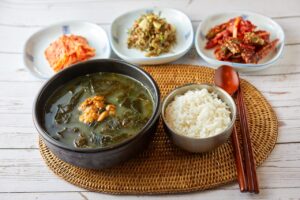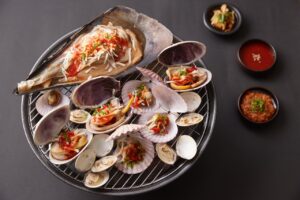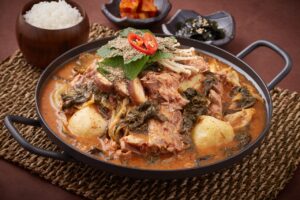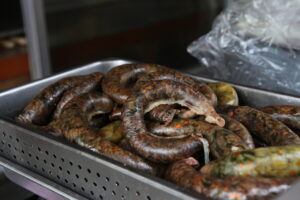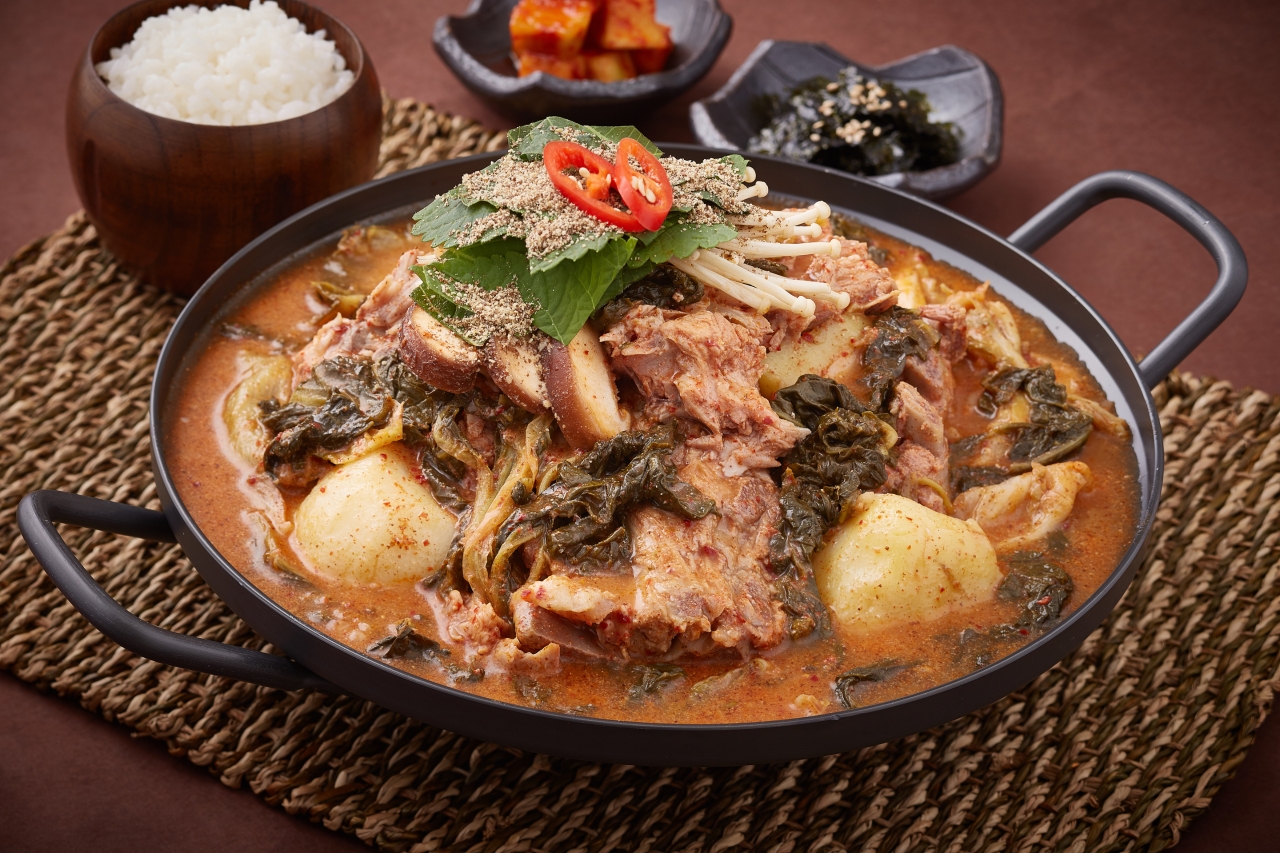
Gamjatang1 ⓒ한국관광공사 사진갤러리 - 디그램
What meas of Gamjatang?
Gamjatang (감자탕) is a popular Korean soup or stew made with pork spine bones, vegetables, and a spicy broth. The name “gamjatang” comes from the Korean word “gamja,” which means potato, and “tang,” which means soup or stew. Despite the name, potatoes are not a primary ingredient in this dish.
The main components of gamjatang include:
Pork Spine Bones: These are the primary protein source in the dish. The bones are typically simmered in the broth until the meat is tender and flavorful.
Vegetables: Various vegetables such as napa cabbage, perilla leaves, bean sprouts, green onions, and sometimes mushrooms are added to the stew.
Spicy Broth: The broth is typically flavored with ingredients like gochugaru (Korean red pepper flakes), gochujang (Korean red pepper paste), garlic, and ginger, giving the dish its characteristic spiciness.
Aromatics: Garlic, ginger, and other seasonings are used to enhance the flavor of the broth.
Gamjatang is a hearty and spicy Korean dish enjoyed for its rich flavors and warming qualities, especially in colder weather. It’s often served with rice and side dishes, making it a satisfying and comforting meal.
History
The history of Gamjatang, a popular Korean dish, is intertwined with Korea’s culinary traditions and the evolution of its cuisine. While there isn’t a specific documented date of origin, we can provide an overview of its historical development.
Korean Culinary Traditions: The roots of Gamjatang can be traced back to Korea’s rich culinary heritage. Korean cuisine has a long history of using a wide variety of ingredients to create flavorful and nourishing dishes. The use of pork in Korean cuisine dates back centuries, and bone-based stews have been a part of Korean cooking for a long time.
Influence of Korean Royal Cuisine: In the Joseon Dynasty (1392-1910), Korean royal cuisine known as “yakgwa” played a significant role in shaping Korean culinary traditions. While Gamjatang may not have originated in the royal court, the emphasis on using various ingredients and spices is a hallmark of Korean cuisine, which influenced the development of dishes like Gamjatang.
Post-Korean War Era: Gamjatang, as it is known today, likely evolved in the post-Korean War era, specifically in the mid to late 20th century. During this time, South Korea was going through significant changes and rebuilding, and the cuisine adapted to the available ingredients and changing tastes.
Ingredients and Flavor Profile: Gamjatang is characterized by its use of pork spine bones, vegetables, and a spicy broth. The addition of spices, especially gochugaru (Korean red pepper flakes) and gochujang (Korean red pepper paste), reflects the spicy and flavorful nature of modern Korean cuisine. While potatoes aren’t a primary ingredient, the name “gamjatang” suggests that they may have been used historically.
Popularity and Regional Variations: Gamjatang has become a beloved dish in South Korea and is enjoyed by many for its rich, spicy flavors. It is also found in Korean restaurants around the world. Different regions and individual cooks may have their variations of Gamjatang, with slight differences in ingredients and preparation methods.
In summary, Gamjatang’s history is rooted in Korean culinary traditions, evolving over time to become the hearty and spicy pork bone stew that is widely enjoyed today. Its exact origins and the evolution of its name may not be precisely documented, but it has become an integral part of Korean cuisine and a popular dish with a rich and diverse flavor profile.

The origin of the name Gamjatang
The name “Gamjatang” (감자탕) is somewhat misleading because it doesn’t actually contain potatoes (감자) as a primary ingredient. The origin of the name is not definitively known, but there are a few theories and speculations about why this dish is called Gamjatang:
Historical Linguistic Shift: One theory suggests that the name “Gamjatang” might be the result of a historical linguistic shift. It is possible that the name was originally different but evolved over time, leading to the inclusion of “gamja,” which means potato. This shift could have been influenced by the dish’s appearance or the use of other vegetables that resemble potatoes.
Metaphorical Name: Another theory is that “gamja” might be used metaphorically in this context. The term “gamja” can also mean something like “comfort” or “warmth.” So, “Gamjatang” could be understood as a comforting, warm, and hearty stew, rather than specifically indicating the presence of potatoes.
Regional Variations: The name might have originated in a specific region or local dialect, and local influences could have contributed to the choice of the name. Different regions in Korea may have slightly varying names for the same dish.
It’s important to note that the name “Gamjatang” has become widely accepted and used to describe this spicy pork bone stew in Korean cuisine, despite the absence of potatoes in the traditional recipe. The exact origin of the name remains somewhat elusive, but it’s a beloved and iconic dish in Korean cuisine known for its rich and spicy flavors.
Cooking Method
Cooking Gamjatang, the spicy Korean pork bone stew, is a relatively simple process, although it may require some time and patience to achieve the best results. Here’s a basic recipe and cooking method for making Gamjatang: Ingredients:
2 pounds of pork spine bones (you can ask your butcher to cut them into small pieces) 1/2 pound of pork belly, thinly sliced
1 small onion, sliced
6-8 cloves of garlic, minced
2 tablespoons of gochugaru (Korean red pepper flakes)
2 tablespoons of gochujang (Korean red pepper paste)
1 tablespoon of soy sauce
1 tablespoon of sesame oil
1 teaspoon of ginger, minced
Salt and pepper to taste
6-8 cups of water
Vegetables: You can use napa cabbage, perilla leaves, bean sprouts, green onions, and other vegetables of your choice.
Instructions:
Blanch the Pork Spine Bones: Place the pork spine bones in a large pot of boiling water. Let them boil for about 5 minutes, then drain and rinse them. This helps remove any excess blood or impurities.
Prepare the Spicy Broth: In a large pot, heat the sesame oil over medium heat. Add minced garlic and ginger, and sauté for a minute until fragrant. Add the gochugaru (Korean red pepper flakes) and gochujang (Korean red pepper paste) and stir-fry for another couple of minutes to release their flavors.
Add the Pork: Add the sliced pork belly to the pot and stir-fry until it starts to brown and become slightly crispy.
Add Water: Pour in 6-8 cups of water (or enough to cover the ingredients) and bring it to a boil. Skim off any impurities or foam that rise to the surface.
Simmer the Pork Bones: Add the blanched pork spine bones to the pot. Reduce the heat to a simmer and let the stew cook for about 30-40 minutes, or until the pork bones are tender and the broth has developed a rich flavor. You can cover the pot, but leave a small gap for steam to escape.
Add Vegetables: Add the sliced onions and any vegetables you prefer to the pot. Napa cabbage, perilla leaves, and bean sprouts are common choices. Simmer for an additional 10-15 minutes, or until the vegetables are tender.
Season: Season the Gamjatang with soy sauce, salt, and pepper to taste. Adjust the spiciness and seasoning according to your preference.
Serve: Gamjatang is typically served hot in a large communal pot. You can ladle it into individual serving bowls and serve it with steamed rice and side dishes.
This is a basic recipe for Gamjatang, but you can adjust the ingredients and seasonings to suit your taste. Gamjatang is often enjoyed with kimchi and other banchan (Korean side dishes) to complement its rich and spicy flavors.
…
…
…
Recommend to Read >>> Sundae, Traditional Korean Blood Sausage.

